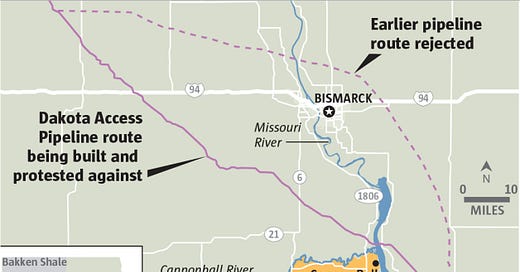Good morning, subscriber!
I hope you’re staying cooler than I am, or that you’re similarly equipped with spray bottles of varying sizes. I have one for every occasion, whether it be writing, walking in the park, walking down a catwalk (part-time gig), or spritzing you one last time with a little contextualization of SCOTUS’ recent madness.
My hot take: it could’ve been worse (barely, very, very, very barely), because there’s a case that the Court decided not to hear related to the Dakota Access Pipeline (DAPL). You might recall that the oil pipeline was the subject of months-long protests in 2016, leading the Obama administration to deny permits for DAPL to cross the Missouri River. Just this year, SCOTUS decided not to hear a final appeal by the Texas energy company behind the pipeline as they attempted to evade an environmental review that could further hold up the flow of crude oil.
The Court’s decision, or lack thereof, was a spot of good news for environmentalists and the Oceti Sakowin, an Indigenous confederacy located nearby. Then again, it was but the latest foray in the Oceti Sakowin’s couple hundred-year-old struggle to retain control of their land. Of note, especially if you’re within my six-foot blast zone, this battle has long revolved around water; in particular a series of dams built in the mid-20th century.
To see what I mean, as well as a lot of maps, let’s head back to the mid-19th century.

Around the time of the Civil War, the US launched a series of other wars against Native Americans, and as the military seized their land, the government encountered a problem: how to inspire would-be settlers to move to arid areas?



